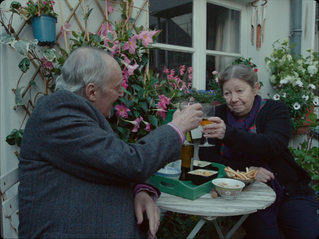The Woman with Two Heads
- Jessica Moore

- Sep 11, 2021
- 2 min read
Updated: May 11
Shûji Terayama, 1977

Behind a girl and her rolling hoop, a shadow hangs against a sheet, as if delicately pinned by a psychic substance. Shadows are spirited. They shape-shift, they follow, they cling; they’re parasitic. They swell and distend; they lure our gaze. They are similar to filmic representations. Attached to and dependent on the figures they replicate, shadows possess an opacity familiar to the screen. They, like items in an image, are untouchable and otherworldly. In film, photographs or paintings, shadows are equal to the bodies that cast them—just as opaque, just as intangible. They dangle before us; we outstretch our arms.
Outside of film, there is an earthliness to shadows. They are recognisable shapes, emptied and refilled with darkness. Bound to truth, at least in part, shadows are extensions of what's there; what’s real.
Shadows are not reflections, however. They are chasms, not mirrors. Mirrors stare back—we are met with ourselves. Shadows, by contrast, are far less confrontational. In the dark, there’s room for manipulation. Shadows belie their assumed honesty, replacing truth with possibility. They contort and spread outward, they indulge in misguidance.
Early cinema used shadows to bewilder. One recalls Robert Wiene’s 1920 Das Cabinet des Dr Caligari and Fritz Lang’s 1931 M. Later, film noir offered its own, often socially critical, employment—anguished men drifting beneath imprisoning shadows. In Ingmar Bergman’s 1966 Persona, identities collapse in the dark; shadows are portals to a mitotic consciousness. Later, and clearly referential to the chiaroscuro of its predecessors, Shuji Terayama’s 1977 The Woman With Two Heads sees shadows as embodied—as soulful, lively figures that depict their own curious visual narratives, at odds with, though somehow related to, the bodies that cast them.
Pliny the Elder claimed the very art of painting began with tracing the edge of shadow, etching its shape. This act of immortalisation becomes an emotional gesture in Terayama’s film. Characters yearn for memories of childhood and intimacy. They see a past just out of reach—through a dark tunnel.
Writing on Japanese aesthetics, author Juni’chiro Tanizaki exalts shadows’ adherence to mono no aware (the art of impermanence). For Terayama, the quest to clasp the intangible holds the centre of his short. Separated from the bodies they visually echo, souls are hidden amidst the depthless and unpredictable motions of the shadows they inhabit. Beginning with a girl and her rolling hoop, moving to a couple in bed, and ending with a woman on a film set with her head in her hands, shadows are severed from their sources, suspended in fantasy. They blur the line between object and sight; they fade and dissolve. Shadows, like memories, can be washed away, relished or refused.
Cut down the middle between material and immaterial, shadows are hosts of invention. With room to move fluidly and unrestrained, they lift bodies out of corporeal limitation. They succumb to the artist's imagination; they are as easily destroyed as they are created.
It seems, at least to Terayama, the indeterminacy of shadows is their most filmic quality. In fact, if one were able to slice a screen in two, poring over its impossible cross-section, perhaps there would only be shadows—drifting through endless celluloid, dancing in the dark.








Comments